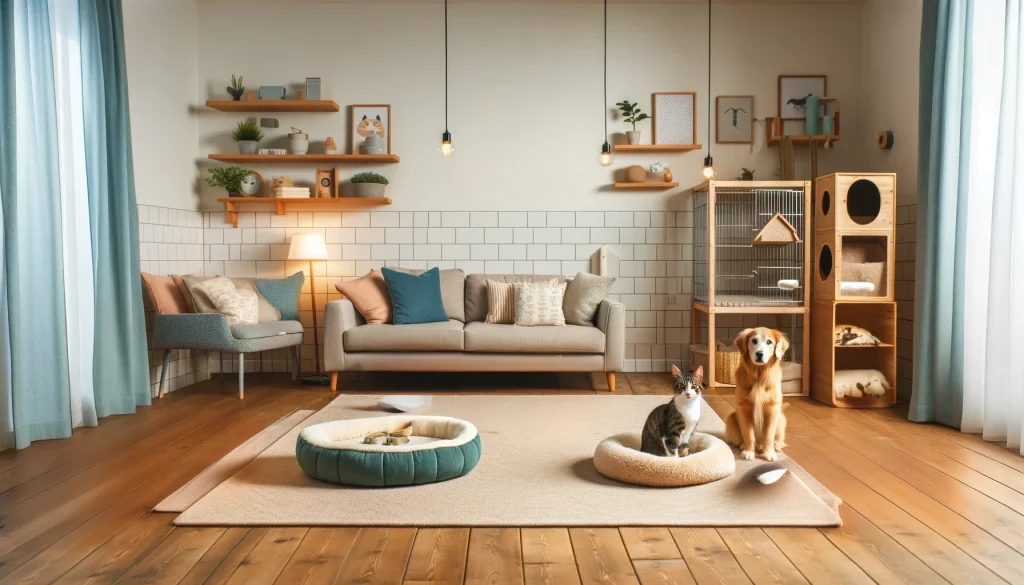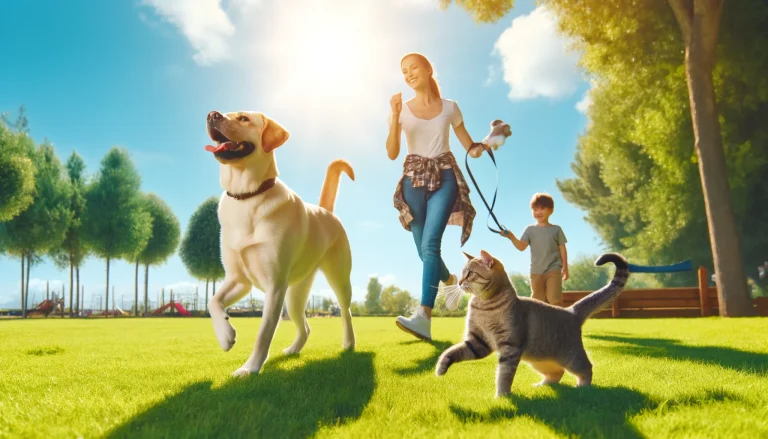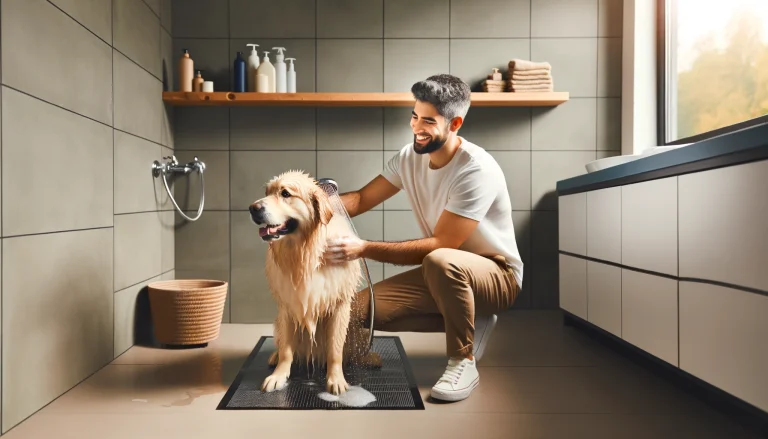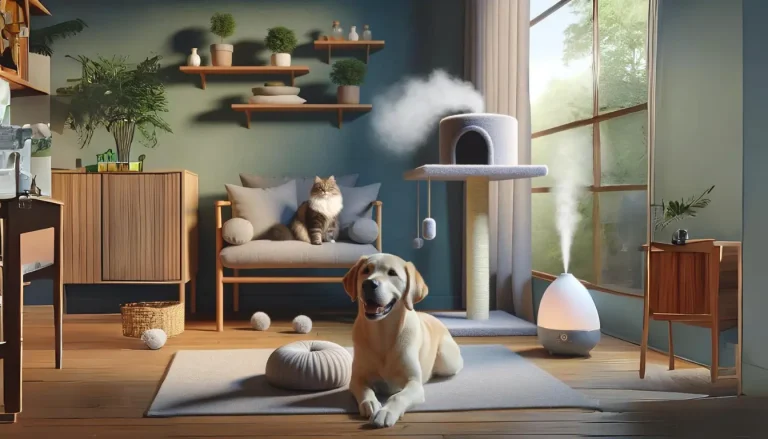Adding a new furry member to your household can be an exciting yet challenging endeavor. It can be an incredibly fulfilling experience to witness your dog and new cat develop a strong bond. Learn the strategies to facilitate a harmonious relationship between your pets with the assistance of this comprehensive guide. Whether your dog is full of energy or your cat is more timid, these valuable tips will enable a peaceful and amicable coexistence between them.
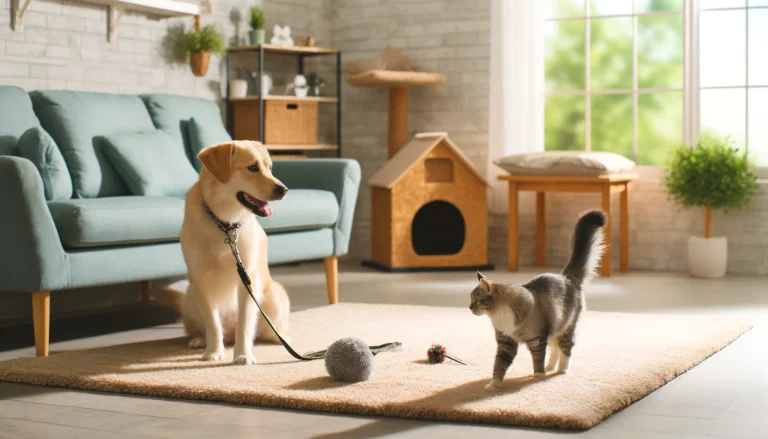
Introducing a new cat to a home with a resident dog can be a nerve-wracking experience. As a pet owner, it’s natural to feel concerned about how your faithful canine companion will respond to the presence of a new feline family member. The good news is that, with the right approach and a bit of patience, it is Remember the text below:
Creating a peaceful coexistence for both pets is achievable. This comprehensive guide will walk you through the entire process, starting from understanding your pets’ distinct personalities to gradually introducing them to each other. By following these expert tips, you can ensure a smooth transition and a joyful home for your dog and your new cat.
Keep in mind that every pet is unique before you begin following the steps. Dogs and cats have distinct behaviors and temperaments that will influence how they interact with each other. Your dog might be energetic and curious, while your cat might be more reserved and cautious. Understanding these differences will be crucial in facilitating a positive relationship between them.
In this all-inclusive guide, we will address every aspect you need to be familiar with regarding preparing your home, conducting the first meeting, establishing routines, and handling any challenges that arise. Creating a harmonious and nurturing environment for all your beloved furry companions, whether they are energetic dogs who thrive on play or reserved cats who cherish their solitude, is essential for their well-being.
Understanding Your Pets’ Personalities
Introducing a new cat to a household with a dog requires understanding each pet’s unique personality. Recognizing and respecting their individual traits can significantly ease the introduction process and set the stage for harmonious coexistence. Here, we will navigate into why it’s important to understand your pets’ personalities, how to assess your dog’s behavior and evaluate your cat’s temperament.
Why Understanding Personalities Matter
Every pet is unique, possessing its own set of behaviors, likes, and dislikes. Acknowledging these differences is crucial because it allows you to tailor the introduction process in a way that minimizes stress and maximizes positive interactions. Just like humans, pets have their comfort zones, and pushing them too quickly into unfamiliar situations can lead to anxiety or aggression. Understanding their personalities helps you create a plan that considers their emotional well-being, fostering a smoother transition.
Assessing Your Dog’s Behavior
To ensure a successful introduction, start by observing your dog’s behavior in various situations. It’s important to observe how your dog responds to unfamiliar animals, strangers, and any alterations in their surroundings. Remember to consider the following key points:
- Friendliness: Is your dog generally friendly and sociable, or are they more reserved around new animals and people? A friendly dog might be more open to accepting a new cat, while a reserved dog may need more time and patience.
- Energy Levels: High-energy dogs might overwhelm a new cat with their playful antics. Understanding your dog’s energy levels will help you plan the introduction at a pace that suits both pets.
- Territorial Behavior: Does your dog exhibit territorial behavior, such as guarding certain areas of the house? If so, you’ll need to address this by creating neutral meeting spaces to prevent possessiveness over territory.
By keeping these observations in mind, you can anticipate how your dog might react to the new cat and plan accordingly.
Evaluating Your Cat’s Temperament
Cats are often more independent and less predictable than dogs, making it essential to understand their unique temperaments before introducing them to a new environment. Here’s what to look for when evaluating your cat’s behavior:
- Socialization History: If your cat has previously lived with other pets, they might adjust more easily to the presence of a dog. Conversely, a cat that has always been the sole pet may require more time to adapt.
- Personality Traits: Is your cat outgoing and curious, or do they prefer solitude and quiet spaces? An outgoing cat might be more willing to explore and meet the dog, whereas a more reserved cat may need extended periods of adjustment.
- Stress Indicators: Keep an eye out for these potential signs of stress in your cat: hiding in unusual spots, excessive grooming leading to fur loss, or changes in eating habits like overeating or refusing to eat. Identifying these signs early on can help you take action to address the stress before it escalates into more serious behavioral or health problems.
Practical Steps to Understanding Your Pets
- Observation: Spend time observing your pets’ behaviors in different scenarios. Note how they react to new stimuli and environments.
- Consult with a Veterinarian: It’s important to engage in a discussion with a knowledgeable veterinarian regarding your pets’ individual personalities and behaviors. Doing so will provide you with valuable insights and personalized recommendations that align with your pets’ unique requirements.
- Behavioral Assessments: Consider professional behavioral assessments for your pets. These can provide detailed information about their temperaments and suggest the best ways to introduce them.
Understanding your pets’ personalities is the foundation of a successful introduction. Take the time to observe and evaluate their behaviors, and you can create a tailored plan that respects their individual needs and paves the way for a peaceful and happy home.
Preparing Your Home for the New Cat
When introducing a new cat to a household with a dog, it is important to take specific steps to ensure a smooth integration. Creating a safe and inviting environment is essential to make both pets feel comfortable. Getting your home ready for multiple pets means setting up separate areas for each pet, establishing safe spaces, and gradually introducing them to each other.
Creating Separate Spaces
Before introducing your new cat to your dog, it’s essential to set up separate areas for each pet. This helps them acclimate to each other’s presence without direct interaction, reducing initial stress and potential conflicts.
Designate Individual Areas
- Cat’s Space: Choose a quiet, low-traffic area of your home for your new cat. This space should include all necessary amenities such as food, water, a litter box, and comfortable bedding. It’s important that this area is off-limits to your dog initially, giving the cat a sense of security.
- Dog’s Space: Ensure your dog has a familiar area where they feel safe and comfortable. This space should also be equipped with food, water, and a cozy resting place. Maintaining your dog’s routine and environment helps reduce their stress during the transition.
Safe Zones for Each Pet
Safe zones are critical in helping both pets feel secure in their environment. These areas act as retreats where they can relax and escape if they feel overwhelmed.
Setting Up Safe Zones
Here are the revised guidelines:
- For the Cat: Create vertical spaces in your home for your feline friend to enjoy, such as tall cat trees or sturdy shelves. These elevated areas provide a sense of security for your cat and allow them to survey their environment from a cozy vantage point. Furthermore, ensure that your space includes hiding spots for your pet, such as enclosed beds or cozy boxes, where they can seek refuge if they feel uneasy or stressed.
- For the Dog: It’s important to create a safe and relaxing space for your dog where they can feel secure. This space could be a cozy crate, a quiet room, or a comfortable bed in a peaceful corner of the house. It’s essential to make sure that your dog can always access this space, giving them a feeling of safety and a spot to de-stress.
Gradual Introduction Process
A gradual introduction process allows both pets to become accustomed to each other’s presence at a comfortable pace, minimizing stress and potential aggression.
Step-by-Step Introduction
- Scent Introduction: Sure, here’s a more descriptive version of the text:
“Prior to introducing your pets face to face, it’s crucial to allow them to get acquainted with each other’s scent. You can accomplish this by exchanging bedding between the two pets to transfer scents, or by using a cloth to transfer scents from one pet to the other. This method encourages your pets to link the new scent with their familiar home environment and helps minimize any stress or anxiety they may experience during the introduction.”
- Controlled Sightings: Once they are familiar with each other’s scent, allow them to see each other from a distance. Use a baby gate or a cracked door to facilitate these sightings. This step helps them get used to seeing each other without direct contact.
- Short, Controlled Meetings: When both pets seem calm and relaxed during controlled sightings, you can begin short, supervised meetings. Keep the dog on a leash to prevent sudden movements, and let the cat move freely. Gradually increase the duration of these meetings as they become more comfortable with each other.
- Positive Reinforcement: During these interactions, use positive reinforcement to encourage calm behavior. Reward both pets with treats, praise, and gentle petting when they remain calm in each other’s presence. This helps them associate positive experiences with being together.
Additional Tips for Preparing Your Home
- Secure Boundaries: Ensure that all escape routes are secured. Cats, in particular, might try to find a way out if they feel threatened. Windows, doors, and other exits should be properly closed or fitted with screens.
- Monitor Initial Interactions: Always supervise the initial interactions between your pets. This allows you to intervene if necessary and ensure that the meetings are safe and positive.
- Patience is Key: Building a strong, positive relationship between your dog and new cat is a process that requires patience and understanding. It’s important to allow them to gradually get to know each other at their own pace. Rushing or forcing interactions can cause setbacks, so it’s crucial to move forward only when both pets are comfortable and ready.
Getting your home ready for a new cat requires consideration and a deep understanding of your pet’s requirements. It involves setting up specific areas, creating safe spaces, and slowly introducing the new cat to your home and existing pets. This preparation aims to minimize stress for all pets involved and establishes the foundation for a long-lasting and positive relationship.
The First Meeting: Tips for Success
The first meeting between your dog and the new cat is a critical step in fostering a harmonious relationship. Properly managing this initial interaction can set the tone for future encounters, helping to build trust and reduce anxiety for both pets. This section offers valuable tips for conducting a successful first meeting, emphasizing the importance of neutral territory, supervised interaction, and positive reinforcement.
Neutral Territory
Choosing the right location for the first meeting is crucial. A neutral space where neither pet feels territorial can help prevent possessive behavior and reduce potential conflicts.
Selecting the Meeting Space
- Avoid Key Territories: Avoid using areas that either pet considers their own, such as the dog’s favorite room or the cat’s designated safe zone. Instead, choose a neutral, less frequently used space in your home.
- Open and Spacious: Ensure the meeting area is open and spacious enough for both pets to move around freely. This allows them to approach or retreat as they feel comfortable.
- Minimize Distractions: Remove any distracting or stimulating objects, such as toys or food bowls. This helps both pets focus on each other without additional stressors.
Supervised Interaction
It’s crucial to provide close supervision during the initial pet introduction to guarantee the safety and well-being of all animals involved. Keeping a watchful eye enables you to quickly address any potential issues and steer the interaction in a positive direction.
Steps for Supervised Interaction
- Leash the Dog: Keep your dog on a leash to prevent any sudden movements or aggressive behavior. This also gives you better control over the situation.
- Allow the Cat Freedom: Let the cat move freely in the meeting area. Cats typically feel more secure when they can explore and retreat as needed.
- Observe Body Language: When introducing two pets, it’s important to observe their body language carefully. When animals exhibit signs of stress or aggression, such as growling, hissing, or raised fur, it means that the interaction may need to be stopped or modified to ensure the well-being of the animals involved.
- Stay Calm and Reassuring: Your pets can sense your emotions. Stay calm and reassuring, using a gentle tone to encourage a positive atmosphere.
Positive Reinforcement
Using positive reinforcement during the first meeting can help both pets associate each other’s presence with pleasant experiences. This technique is effective in promoting calm and friendly behavior.
Implementing Positive Reinforcement
- Treats and Praise: Have plenty of treats on hand to reward both pets for calm and non-aggressive behavior. Praise them with a soothing voice and gentle petting when they display positive interactions.
- Short Sessions: Keep the initial meetings short, gradually increasing the duration as both pets become more comfortable. End each session on a positive note, with both pets receiving treats and praise.
- Consistency: Be consistent with your rewards. Reinforce positive behavior every time they interact well. Consistency helps reinforce the association between being together and receiving rewards.
Monitoring and Adjusting
Each time you introduce new pets to each other, it’s crucial to closely observe their interactions and be willing to make changes as necessary. Keep in mind that some pets might need extra care and time to get used to one another.
Tips for Monitoring and Adjusting
- Be Patient: Building a strong and positive bond with your pets is a gradual process that requires patience. It’s important to allow your pets to develop and grow at their own speed, respecting their individual personalities and preferences along the way.
- Gradual Progression: Gradually increase the length and frequency of meetings as both pets become more comfortable. Do not rush the process, as forcing interactions can lead to setbacks.
- Seek Professional Help if Needed: If you encounter persistent issues or aggressive behavior, consider seeking help from a professional animal behaviorist. They can provide tailored strategies to address specific challenges.
Common Challenges and Solutions
In your first meeting, despite thorough preparation and planning, you may face some unexpected challenges. It’s important to be aware of these common hurdles and have effective strategies to address them. Even with your best efforts, encountering difficulties is possible. However, don’t fret! I can help you navigate these issues by providing solutions for common challenges. Continue reading to ensure a smooth sailing during your meeting.
- Aggressive Behavior: When your dog present aggressive behavior towards other pets, it’s important to separate them right away and give them some time apart. When you’re ready to reintroduce them, take it slow and use a more controlled approach to help them adjust to each other again.
- Excessive Fear or Stress: If your cat seems excessively fearful or stressed, provide them with more time in their safe zone before attempting another meeting. Use calming aids, such as pheromone diffusers, to reduce anxiety.
- Lack of Interest: Sometimes, pets may ignore each other. While this isn’t necessarily negative, continue with gradual introductions and positive reinforcement to encourage interaction over time.
Successfully managing the first meeting between your dog and the new cat involves careful planning, supervision, and positive reinforcement. By choosing a neutral territory, closely monitoring the interaction, and consistently rewarding calm behavior, you can set the stage for a positive relationship. Remember that when creating a peaceful and harmonious home for your pets, patience and persistence are key. Every small step you take forward, whether it’s setting up a comfortable space for your pets or helping them adjust to a new routine, is a victory in building a happy environment for them.
Building a Routine
Establishing a consistent routine is vital in aiding your dog and new cat in adjusting to each other and coexisting harmoniously. A regular schedule offers stability and decreases anxiety for both pets, which is essential for a seamless integration process. This section will explore the importance of sticking to regular feeding schedules, participating in interactive play sessions together, and giving each pet individualized attention to foster a harmonious and stable bond with your furry friends.
Consistent Feeding Times
Feeding times are significant moments in your pets’ daily routine. Establishing consistent feeding schedules helps create a sense of security and reduces potential conflicts over food.
Setting Up Feeding Schedules
- Separate Feeding Areas: Initially, feed your dog and cat in separate areas to prevent any competition or stress. This ensures both pets can eat comfortably without feeling threatened.
- Scheduled Meal Times: Stick to regular meal times for both pets. Consistency in feeding schedules helps them anticipate and adapt to the daily routine.
- Monitor Interactions: Gradually bring their feeding areas closer together as they become more comfortable with each other. Supervise these interactions to ensure there is no food aggression.
Shared Playtime
Playtime is an excellent opportunity to build a bond between your dog and cat. Shared activities can encourage positive interactions and help them view each other as companions rather than rivals.
Encouraging Positive Play
- Interactive Toys: Use toys that both pets can enjoy, such as laser pointers, feather wands, or interactive puzzle toys. These toys stimulate their natural instincts and promote cooperative play.
- Supervised Sessions: It’s important to closely monitor playtime when pets are interacting together, especially at the start. This way, you can step in if the play gets too aggressive or if one of the pets starts feeling stressed.
- Short and Positive: During playtime, it’s crucial to ensure that the sessions are kept brief and concluded with positive interactions. As your pets grow more accustomed and at ease with each other, you can slowly extend the length of their play sessions.
Maintaining Individual Attention
While it’s important to encourage shared activities, ensuring that each pet receives individual attention is equally crucial. This helps prevent jealousy and ensures both pets feel valued and secure.
Balancing Attention
- Dedicated Time: Set aside specific times each day to spend individually with your dog and cat. This can include solo playtime, training sessions, or simply cuddling and petting.
- Respect Individual Needs: Recognize and respect each pet’s individual needs and preferences. For instance, some cats may prefer quiet, solitary activities, while dogs might enjoy more interactive play.
- Rotate Activities: Rotate the activities you do with each pet to keep them engaged and prevent boredom. This also helps you bond with each pet in different ways.
Implementing a Routine
Creating a routine involves more than just feeding and playtime. It encompasses all aspects of your pets’ daily lives, including exercise, rest, and social interactions.
Daily Routine Checklist
- Morning Routine: Begin your day with a regular morning routine that includes providing food, taking bathroom breaks, and engaging in a short play session. This helps to establish a positive and proactive start to the day.
- Midday Activities: Incorporate midday activities such as interactive play or training sessions. Ensure both pets have time to rest and relax during the day.
- Evening Routine: End the day with a calm evening routine, including feeding, a final bathroom break, and quiet time. This helps both pets wind down and prepares them for a restful night.
- Exercise and Enrichment: Ensuring that both pets receive regular physical exercise and mental stimulation is crucial for promoting their overall well-being. Providing opportunities for activities that engage their bodies and minds can help maintain their health and happiness.Make it a priority to take your dog for daily walks and offer stimulating activities to keep your cat engaged, such as using puzzle feeders or providing climbing structures for them to explore.
Addressing Routine Challenges
Even with a carefully organized schedule, unexpected obstacles may crop up. Being prepared to tackle these challenges is crucial for keeping things running smoothly and avoiding any disruptions.
Common Challenges and Solutions
- Inconsistent Schedules: Life can be unpredictable, and sometimes it’s challenging to stick to a strict schedule. Try to maintain as much consistency as possible and make adjustments gradually to avoid causing stress.
- Behavioral Issues: If either pet shows signs of behavioral issues, such as aggression or anxiety, assess their routine and identify potential stressors. Adjusting the routine or seeking professional help can address these issues.
- Health Concerns: Remember to carefully monitor the overall well-being of both pets. Any alterations in their eating habits, activity levels, or demeanor could indicate underlying health concerns. It’s crucial to arrange routine appointments with a veterinarian to ensure that they maintain good health and well-being.
Positive Reinforcement in Routines
Incorporating positive reinforcement into your daily routine can significantly enhance your pets’ behavior and interactions.
Reinforcement Techniques
- Rewards for Calm Behavior: Consistently reward calm and positive behavior with treats, praise, or playtime. This encourages your pets to continue behaving well.
- Routine Reinforcement: Use the same cues and rewards for routine activities, such as feeding or playtime. This consistency helps your pets understand and anticipate their daily schedule.
- Gradual Adjustments: When making changes to the routine, do so gradually and reinforce the new schedule with positive experiences. This helps both pets adapt smoothly.
Establishing a consistent routine is crucial for creating a peaceful and harmonious relationship between your dog and new cat. By setting regular feeding times, facilitating play sessions together, and ensuring each pet receives individual attention, you are laying the foundation for a stable and secure environment for both animals. A well-balanced and predictable routine can help alleviate anxiety, minimize potential conflicts, and encourage positive interactions, ultimately fostering a serene and joyful home for your pets.
Handling Challenges
Introducing a new cat to your dog is a journey that may come with its fair share of challenges. It is crucial to be prepared to address these challenges with a calm and empathetic approach. This section will cover identifiable indicators of stress, impactful strategies for modifying behavior, and the significance of maintaining patience and perseverance to establish a harmonious relationship.
Signs of Stress
To ensure your pets’ well-being, it’s crucial to be able to identify signs of stress in your dog and cat. These signs can manifest in various ways, including changes in behavior or physical symptoms. By recognizing these indicators, you can take proactive measures to address your pet’s stress and help improve their overall quality of life.
Common Stress Indicators in Dogs
- Aggression: Growling, snapping, or barking excessively can indicate that your dog is feeling threatened or stressed.
- Restlessness: Pacing, whining, or other restless behaviors may show that your dog is uncomfortable with the new situation.
- Avoidance: If your dog is avoiding certain areas of the house or the cat altogether, this can be a sign of stress.
Common Stress Indicators in Cats
- Hiding: Cats often hide when they are stressed. This could mean they are not yet comfortable with the new environment or the dog.
- Hissing or Growling: Vocal signs like hissing or growling are clear indicators that your cat feels threatened.
- Changes in Eating Habits: A stressed cat may eat less or more than usual or even stop eating altogether.
Behavioral Training
Behavioral training can be instrumental in helping both your dog and cat adjust to each other. Conditioning helps manage and mitigate aggressive or fearful behaviors, fostering a more harmonious relationship.
Training Your Dog
- Basic Commands: Ensure your dog is well-versed in basic commands such as sit, stay, and leave it. These commands can help manage your dog’s behavior during interactions with the cat.
- Desensitization: Gradually expose your dog to the cat’s presence while rewarding calm behavior. This helps your dog become accustomed to the cat without reacting aggressively.
- Professional Help: If your canine consistently displays aggressive behavior, it’s important to consider getting assistance from a dog trainer or behavior specialist. These professionals can offer personalized strategies to tackle the specific issues you are facing with your dog’s behavior.
Training Your Cat
- Safe Retreats: Encourage your feline friend to make use of safe havens, such as high perches or specific secluded spots, when they experience stress. This practice aids in fostering a sense of security within their surroundings.
- Positive Reinforcement: To encourage your cat to remain calm around the dog, you can use treats and praise to reward their composed behavior. By employing positive reinforcement, your cat can start to form positive associations with the presence of the dog.
- Gradual Exposure: Similar to dogs, gradually expose your cat to the dog’s presence, starting with short, controlled interactions and slowly increasing the duration.
Patience and Persistence
Create a positive relationship to your dog and cat requires time, patience, and persistence. Each small step forward is progress, and setbacks are a natural part of the process.
Tips for Patience and Persistence
- Celebrate Small Wins: Recognize and celebrate small milestones, such as your dog and cat calmly being in the same room. These small successes add up over time.
- Avoid Rushing: Do not rush the introduction process. Allow both pets to progress at their own pace, ensuring they feel comfortable and secure at each stage.
- Consistency : Maintain a consistent routine and approach to training. Consistency helps reinforce positive behaviors and reduces anxiety.
- Stay Calm and Positive: Your pets can sense your emotions. Staying calm and positive will help create a reassuring environment for both of them.
Common Challenges and Solutions
Even with careful planning, you may encounter some common challenges. Here are solutions to help you navigate these issues effectively.
Aggressive Behavior
- Immediate Separation: If aggressive behavior occurs, immediately separate the pets and give them a break. Use calming techniques and reintroduce them slowly.
- Controlled Interactions: Use leashes, baby gates, or other barriers to control interactions and prevent aggressive encounters. Gradually increase their time together as they adjust.
Excessive Fear or Stress
- Extended Adjustment Period: Give your pets more time to adjust in their safe zones. Provide comforting items like blankets or toys to reduce stress.
- Calming Aids: Consider using calming aids such as pheromone diffusers or anxiety wraps to help reduce stress levels in both pets.
Lack of Interest
- Encouraged Interaction: Use interactive toys and activities to encourage your pets to interact. Sometimes, pets need a little encouragement to engage with each other.
- Shared Activities: Engage both pets in shared activities like playing with a laser pointer or chasing a feather toy. This promotes positive interactions and helps build their bond.
Handling challenges during the introduction of a new cat to your dog involves recognizing signs of stress, implementing effective behavioral training, and maintaining patience and persistence. By staying attentive to your pets’ needs and adjusting your approach as necessary, you can overcome these challenges and foster a peaceful and harmonious relationship between your dog and cat.
FAQs
How long does it take for a dog and a cat to get along?
The time it takes for a dog and a cat to get along varies significantly depending on their personalities, past experiences, and the introduction process. Some pets may start to get along within a few days, while others might take several weeks or even months. Unlocking success requires patience and a steady stream of positive reinforcement.
What if my dog is too aggressive towards the cat?
If your dog shows aggressive behavior toward the cat, it’s crucial to intervene immediately. Separate them and allow both pets to calm down. Gradually reintroduce them using controlled and supervised interactions. For further assistance, it’s highly recommended to consider consulting a certified dog trainer or a qualified animal behaviorist who can provide support and expert advice tailored to your specific situation.
Can all dogs and cats get along?
While many dogs and cats can learn to coexist peacefully, not all will become best friends. Some pairs may only tolerate each other, while others may develop a strong bond. Remember, it’s vital to keep realistic expectations in check and concentrate on nurturing a harmonious coexistence.
How do you know if your cat is feeling stressed out?
Cats display signs of stress in various ways. These signs may include hiding in secluded spots, hissing, growling, changes in eating habits such as overeating or undereating, excessive grooming leading to hair loss or skin irritation, and avoiding interactions with humans or other animals. Providing a safe space, reducing environmental stressors, and using calming aids can help alleviate stress in your cat.
Should I keep them separated at night?
Initially, it’s a good idea to keep your dog and cat separated at night until they are more comfortable with each other. Gradually allow them to share spaces once you’re confident they can coexist peacefully without supervision.
What are the best toys to help them bond?
Interactive toys that both pets can enjoy are ideal for encouraging bonding. Laser pointers, feather wands, and puzzle toys can engage both your dog and cat, promoting positive interactions and shared playtime.
Conclusion
When you bring a new cat into a home with a dog, it’s important to remember that the process can be tricky but ultimately rewarding. Understanding the personalities and behaviors of both pets is essential for a successful introduction. It may take time and patience, but a positive and safe approach can lead to a harmonious relationship between the two animals. Understanding the unique personalities of your pets is crucial when introducing them to a new environment. Take some time to observe their behaviors, preferences, and reactions to different situations. By keeping this in mind, you’ll be able to predict their reaction to having another animal in the house.
In addition, thoroughly preparing your home for the arrival of a new pet is essential. This includes creating separate spaces for the dog and the cat, providing adequate food and water, and removing any potential hazards or stress-inducing elements. Ensuring that each pet has their own territory and resources will help mitigate potential conflicts and establish a sense of security.
To ensure a harmonious relationship between your pets, it’s crucial to follow a structured introduction process. One effective method involves a gradual introduction of the animals in a controlled environment. This allows them to become accustomed to each other’s scents and presence before engaging in direct interaction. Patience, close supervision, and positive reinforcement are essential components in this process.
By prioritizing these steps, you can establish a harmonious and safe environment where both animals feel comfortable and secure, setting the foundation for a peaceful coexistence.
Developing a harmonious relationship to your dog and a new cat requires careful and intentional steps to ensure a smooth and positive integration. By establishing a consistent routine and approaching challenges with little patience and persistence, you can create a balanced and supportive environment for both pets. Utilizing positive reinforcement techniques can further help to build trust and comfort between the animals.
Please remember the following advice:
The bond between a dog and a cat can be truly special, but it’s important to remember that every pet is unique, and the process of helping them coexist peacefully may vary. It’s essential to celebrate small victories and remain patient as your pets acclimate to each other. With dedication, time, and the appropriate approach, you can help your dog and your cat learn to live together harmoniously, ultimately bringing joy and companionship to your home.
Check out our blog for the latest and greatest pet care tips!
Thank you for reading our guide on introducing your dog to a new cat. We trust you have found the information both helpful and inspiring. For additional tips and guidance on pet care, don’t forget to check out our blog.
Our blog is packed with articles on a wide range of pet care topics, including:
- Training Tips: Discover effective training techniques for both dogs and cats to ensure a well-behaved and happy household.
- Health and Nutrition: Learn about the best diets, exercise routines, and healthcare practices to keep your pets in top shape.
- Behavioral Insights: Understand common pet behaviors and how to address any issues that arise.
Explore our blog to uncover a treasure trove of expert advice, heartwarming stories, and valuable tips designed to help you provide the best possible care for your beloved furry friends. Our goal is to help pet owners create nurturing and joyful homes for their pets.
Discover our newest articles and become part of our amazing community of pet enthusiasts today!

